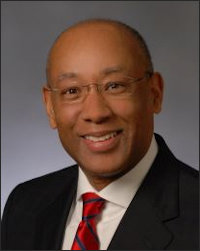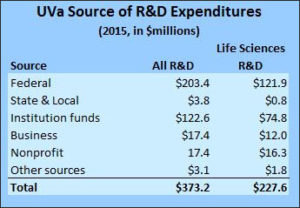
David S. Wilkes, dean of the UVa schools of medicine
The Trump administration’s proposed budget cuts to the National Institutes of Health will make it harder to find new cures — and harder to create new jobs, contends David S. Wilkes, dean of the University of Virginia’s School of Medicine. In 2016 UVa received $126 million in NIH funding, accounting for about 60% of its research funding.
NIH backing allowed UVa researchers to discover a link between the brain and immune system, potentially leading to treatments of neurological diseases such as autism and Alzheimer’s. An NIH-supported clinical trial is providing the final tests for a UVa-developed artificial pancreas that can help people with Type 1 diabetes. Meanwhile, scientific research at UVa is stimulating the rise of a job-creating innovation ecosystem in the Charlottesville area. Writing in the Richmond Times-Dispatch op-ed page, Wilkes says:
In 2016, the National Venture Capital Association ranked Charlottesville as the fastest-growing venture capital ecosystem in the U.S., and medical start-ups are [an] important part of that boom.
U.Va. Innovation, which helps bring U.Va. research discoveries to the marketplace, has identified more than 50 active companies advancing U.Va. discoveries. Many of those companies were founded to develop U.Va. medical research breakthroughs.
A study conducted by the research firm Tripp Umbach found that in fiscal year 2015, U.Va. School of Medicine’s research generated an economic impact to Virginia of $425.4 million. That economic impact would be greatly diminished if NIH funding were slashed.
Bacon’s bottom line: One can pick at these numbers, but let us accept them as valid for the moment. Wilkes is making the argument that what’s good for UVa research is good for Virginia economic development. Advocates of investing in life sciences are employing similar logic for life-science initiatives in Northern Virginia, Richmond, Norfolk and Roanoke.
UVa is playing a hyper-competitive industry sector, however, and it starts with big competitive disadvantages as it tries to build a biomedical ecosystem from scratch in a small metropolitan area. According to the 2016 Jones Lang Lasalle study, the Boston, San Francisco, Raleigh-Durham and San Diego metropolitan areas have the nation’s leading life-sciences clusters. None of the top 16 clusters are located in Virginia. The closest geographically is the “Maryland suburbs/D.C. metro.” It takes a lot more than a research university to play in this sandbox. A large labor pool is a necessity for recruiting top scientific and entrepreneurial talent, and UVa’s location in little Charlottesville presents a big handicap.
If UVa were investing only its endowment dollars in competing for NIH grants and other life-science research, that would be UVa’s business and nobody else’s. As long as the money for this initiative comes exclusively from wealthy alumni and philanthropists, and as long as Virginia taxpayers, tuition-paying families, and bill-paying patients of UVa’s medical system are held harmless, no one has grounds for complaint.
Unfortunately, UVa isn’t relying solely upon wealthy donors to fund its ambitions to build a world-class medical research center. UVa has developed mechanisms to extract wealth from others — patients, students, taxpayers — to underwrite its efforts. Because these mechanisms are so opaque, however, no one in Virginia sees them.
Wilkes does mention one of these funding sources, UVa’s controversial, $2.1 billion Strategic Investment Fund, in a positive light. The fund was cobbled together from various pots of money which were generating minimal investment returns. By combining these pools of money and handing them over to the University of Virginia Investment Management Company, the university hopes to generate an estimated $100 million a year in investment revenue. The Board of Visitors has approved using most of this money for institutional advancement, including R&D. But that is a choice. Alternatives include using the money to reduce tuition, bolster financial aid, or build non-research programs. Accordingly, students and parents who pay tuition, and the Commonwealth of Virginia, which pays millions of dollars in state support, have a direct interest in how Strategic Investment Fund proceeds are allocated.

According to the National Science Foundation, a third of UVa’s R&D expenditures are internally generated (classified as “institution funds” in the table to the left). Institution funds amounted to $74.8 million for life sciences and $122.6 million for all R&D in 2015 — before the Strategic Investment Fund existed.
I could not find a definition of “institution funds” on the NSF website, but I expect that it includes monies flowing from one or all of the following: (1) the university’s endowment, which is funded by philanthropy; (2) discretionary academic monies, which are funded through tuition and state support; and/or (3) surplus revenues (profits) from the UVa Medical Center, which is derived from patient revenues. To the extent that UVa research is funded by tuition, tax dollars, and patient revenues to cover buildings, faculty, grad students administrative overheard, and the like, it is fair to say that students, taxpayers, and patients are subsidizing research. The size of that subsidy remains a mystery. I don’t believe UVa (or any other Virginia public university) publishes such a number. It may not even calculate a number.
While R&D-generated economic development might be a good thing for Charlottesville and Virginia from the perspective of creating high-paying research and technology jobs, much of the funding ultimately comes from populations who have no idea what they’re subsidizing. Students are paying higher tuition (and accumulating more debt) and patients are paying more for medical services. The system is so opaque, the accounting so arcane, that no one sees or understands these wealth transfers. Perhaps the economic development is worth the cost of higher tuition and patient fees, but who can say unless we have an open and honest conversation?


